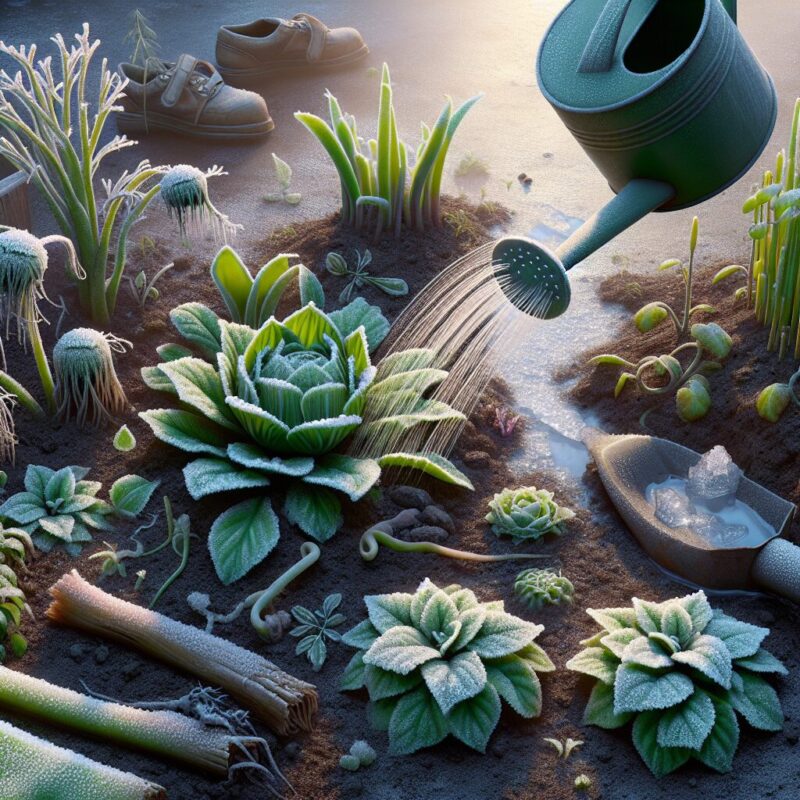When To Water Plants After A Freeze is a crucial aspect that every gardener should be aware of. Freezing temperatures can have a significant impact on plants, affecting their overall health and well-being. It is important to understand the right time to water plants after a freeze to ensure their survival and promote their recovery.
After a freeze, plants may experience damage to their cell structure, leading to potential dehydration. This occurs as water in the plant cells freezes, causing the formation of ice crystals that can rupture cell walls. Once the freeze is over, it becomes essential to provide plants with the necessary moisture to support their healing and growth. However, the timing of watering is crucial, as watering too soon after a freeze can exacerbate the damage.
In the upcoming sections, we will explore the key takeaways to consider when determining the appropriate time to water plants after a freeze. We will delve into factors such as plant type, signs of frost damage, and methods of assessing soil moisture levels. By understanding these key takeaways, you will be equipped with the knowledge needed to make informed decisions and provide the best care for your plants after a freeze.
Key Takeaways
1. Wait to water plants until the ground has thawed and the danger of frost has passed to prevent ice crystals from damaging the roots.
2. Avoid overwatering plants immediately after a freeze as this can lead to rot and other complications. Instead, allow the soil to naturally thaw and moisten gradually.
3. Inspect plants for signs of damage, such as wilted or discolored leaves, before deciding whether to water them. Watering damaged plants too soon can exacerbate their condition.
4. Use a moisture meter or a finger test to check the moisture level of the soil before watering. If the soil feels dry up to a depth of 2-3 inches, it is likely time to water the plants.
5. Adjust watering frequency based on the specific needs of each plant and the prevailing weather conditions. As temperatures warm up after a freeze, plants may require more water to recover and thrive.
When is the Best Time to Water Plants After a Freeze?
Understanding the Impact of a Freeze on Plants
Freezing temperatures can be detrimental to plants, causing damage to their cells and tissues. When plants are exposed to freezing temperatures, ice crystals form within their cells, leading to cell damage and even death. Once the freeze is over, it is important to take the necessary steps to ensure the health and recovery of your plants. One crucial aspect is knowing when to water them after a freeze.
Wait for Thawing to Occur
After a freeze, it is crucial to wait until the temperature rises above freezing and the ice on and around the plants has thawed. Watering plants while they are still frozen can further damage the delicate tissues. Additionally, watering frozen plants can lead to the formation of more ice crystals, exacerbating the damage caused by the initial freeze. Therefore, it is best to be patient and allow the plants to thaw naturally before providing any water.
Checking the Plant’s Condition
Before watering your plants after a freeze, it is essential to assess their condition. Inspect the leaves, stems, and overall appearance of the plant. If you notice any signs of damage, such as wilting, discoloration, or a mushy texture, postponing watering might be necessary. Damaged plants often struggle to absorb water effectively, and introducing excess moisture can worsen their condition. However, if the plants appear healthy and undamaged, watering can be considered.
Monitoring the Soil Moisture
Checking the soil moisture is crucial when determining when to water your plants after a freeze. Before watering, assess the top layer of soil by inserting your finger about one inch deep. If the soil feels dry, providing water is necessary. However, if the soil is still moist, it is best to wait a little longer. Remember that freezing temperatures can restrict water absorption, and overwatering can lead to root rot and other plant diseases.
Optimal Time for Watering
The optimal time to water plants after a freeze is in the morning. By watering in the morning, you allow the plants to absorb the moisture throughout the day while ensuring that excess water has time to evaporate before evening. Watering in the evening can increase the risk of fungal diseases, as the plant’s leaves may remain wet for an extended period. Additionally, watering during the warmer hours of the day can lead to excessive water loss through evaporation.
Guidelines for Watering After a Freeze:
- Ensure the temperature rises above freezing and the ice has thawed before watering.
- Check the plant’s condition for signs of damage. Postpone watering if necessary.
- Assess the soil moisture. Water only if the soil feels dry one inch deep.
- Water in the morning for optimal absorption and to allow excess moisture to evaporate.
- Avoid watering in the evening to reduce the risk of fungal diseases.
- Do not overwater to prevent root rot and other plant diseases.
- Monitor the plants’ recovery and adjust watering frequency accordingly.
Frequently Asked Questions
1. Can I water my plants immediately after a freeze?
It is not recommended to water your plants immediately after a freeze. The frozen soil can cause root damage, and the water may freeze on the plant’s foliage, causing further harm.
2. How long should I wait to water my plants after a freeze?
It is best to wait until the temperatures have warmed up above freezing consistently for a few days before watering your plants. This helps ensure that the soil and plants have thawed completely.
3. Will my plants recover on their own without water after a freeze?
In most cases, plants can recover from a freeze without additional watering. However, if the freeze was severe or prolonged, some plants may require supplemental watering to aid in their recovery.
4. Should I water my plants during a thaw?
During a thaw, you generally do not need to water your plants unless the soil has become excessively dry. The natural melting of ice and snow will provide sufficient moisture for most plants.
5. Can I water my plants if they appear wilted after a freeze?
If your plants appear wilted after a freeze, it is important to assess the extent of the damage first. In some cases, watering may help revive the plants, but in severe cases, the damage may be irreversible.
6. What should I do if the soil is still frozen?
If the soil is still frozen, it is best to avoid watering until it thaws. Watering frozen soil can lead to compaction and damage to the plant’s roots.
7. How can I prevent freeze damage to my plants?
To prevent freeze damage, you can cover your plants with protective materials, such as burlap or blankets, before a freeze. This can help insulate them from the cold temperatures and reduce the risk of damage.
8. Should I water indoor plants after a freeze?
For indoor plants, watering should be governed by their individual moisture needs, rather than the occurrence of a freeze. Check the soil moisture levels and water accordingly to maintain optimal conditions.
9. When is the best time to assess freeze damage and water accordingly?
To accurately assess freeze damage and water accordingly, it is advisable to wait until the temperatures have consistently warmed up above freezing for a few days. This allows the plants to recover naturally, and any damaged areas become more evident.
10. Are there any signs that indicate my plants require water after a freeze?
If your plants show signs of extreme wilting, browning, or brittleness after a freeze, it may indicate that they require additional watering. However, always inspect the plants thoroughly to determine the extent of the damage before providing water.
Final Thoughts
When it comes to watering your plants after a freeze, patience is key. Rushing to water immediately after a freeze can do more harm than good. Take the time to assess the damage and wait until the soil and plants have thawed adequately. Remember that not all plants will require additional watering after a freeze, so monitoring their recovery is vital.
By following the recommended guidelines and waiting for the appropriate time to water, you can help your plants rebound and thrive after a freezing event. Keep in mind that prevention is always better than cure, so take proactive measures to protect your plants before a freeze occurs. With proper care and attention, your plants will continue to beautify your garden despite the challenges of freezing temperatures.

